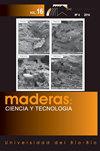刨花板和中密度纤维板不同尺寸销钉拔力能力的预测表达式
IF 1.5
4区 农林科学
Q3 MATERIALS SCIENCE, PAPER & WOOD
引用次数: 0
摘要
本研究的目的是建立不同尺寸山毛榉(Fagus orientalis)榫在中密度纤维板(MDF)和刨花板(PB)上的拔力能力的预测表达式。此外,还研究了基材类型、销钉直径、销钉穿透度和胶粘剂类型对吸出力的影响。采用聚氨酯(PU)、聚醋酸乙烯基D2和聚醋酸乙烯(PVA)胶粘剂粘接销子。共制备540个试样进行边面拔力容量试验,包括两种材料类型(MDF、PB)、三种销钉直径(6 mm、8 mm、10 mm)、三种销钉入深(15 mm、20 mm、25 mm、6 mm、9 mm、12 mm)、三种胶粘剂类型,每组5个重复。试件在静拔力作用下进行测试。根据测试结果,开发了预测表达式,使家具工程师能够根据销钉直径和销钉穿透程度估算销钉的边缘和面提取力能力。计算结果表明,所建立的计算公式可以合理地估计销钉的拔力能力。统计分析结果表明,材料类型、榫径、榫入度、胶粘剂类型及其四向相互作用对榫的抽拔能力有显著影响。试验结果还表明,在胶粘剂和材料类型中,PU胶粘剂和中密度纤维板的抗拔力能力最高。增大销钉直径或贯入对抽拔力能力有正向影响。销孔直径对抽拔力的影响大于销孔深度。用聚氯乙烯(PVAc)和聚氨酯(PU)胶粘剂与MDF和PB表面平行和垂直粘合。在与PVAc胶粘剂垂直粘合在MDF表面的山毛榉销钉中获得了最高的拉伸强度,强度为7,91 MPa。Uysal和Kurt(2007)研究了封边厚度、销钉尺寸、材料类型和用于封边的粘合剂类型对销钉拉拔强度的影响。结果表明:采用厚度为10 mm的白栎实木镶边与热熔胶粘结的中密度纤维板,直径为6 mm的山毛榉销钉拔拔强度最高,达到7019 MPa;在Yapıcı等人进行的类似研究中。(2011),确定边缘封边厚度、销钉尺寸、材料类型。封边所使用的胶粘剂类型对销钉的拉拔强度有显著影响。对于直径为8 mm的MDF,实木厚度为5 mm的PU胶粘接山毛榉边缘带,他们获得了最高的拔拔强度(6,68 MPa)。Kurt等人。(2009)测定了直径为6mm、8mm、10mm的山毛榉销钉相对于边沿为5mm、10mm和15mm的MDF或PB的拔拔强度本文章由计算机程序翻译,如有差异,请以英文原文为准。
Predictive expressions for withdrawal force capacity of various size of dowels from particleboard and medium density fiberboard
The objective of this study was to develop predictive expressions for estimating the withdrawal force capacity of various size of beech ( Fagus orientalis ) dowels from medium density fiberboard (MDF) and parti cleboard (PB). Furthermore, effects of the base material type, dowel diameter, dowel penetration and adhesive type on withdrawal force capacity were investigated. Polyurethane (PU), polyvinyl acetate based D2, and polyvinyl acetate (PVA) adhesives were utilized for gluing of dowels. A total of 540 specimens were prepared for edge and face withdrawal force capacity tests including two material types (MDF, PB), three dowel diameters (6 mm, 8 mm, 10 mm), three dowel penetration depths (15 mm, 20 mm, 25 mm for edge, 6 mm, 9 mm, 12 mm for face), three adhesive types and five replications for each group. Specimens were tested under static withdrawal forces. Based on results of tests, predictive expressions that allow furniture engineers to es timate edge and face dowel withdrawal force capacity as a function of dowel diameter and dowel penetration were developed. Calculations showed that the expressions developed provided reasonable estimates for withdrawal force capacity of dowels. As a result of statistical analyses, material type, dowel diameter, dowel pene -tration, adhesive type and their four-way interaction have significantly affected the withdrawal force capacity of dowels. Test results also indicated that PU adhesive and MDF ranked the highest withdrawal force capacity among the adhesive and material types. Increasing either dowel diameter or penetration tended to have a positive effect on withdrawal force capacity. Dowel diameter was found to have a higher effect on withdrawal force capacity than dowel penetration. orientalis ), bonded parallel and vertical to the surface of MDF and PB with polyvinylacetate (PVAc) and Polyurethane (PU) adhesives. They obtained the highest withdrawal strength in beech dowels bonded ver-tically with PVAc adhesive to the surface of MDF at 7,91 MPa. Uysal and Kurt (2007) investigated the effects of edge banding thickness, dowel dimension, type of material and type of adhesive used for edge banding on the withdrawal strength of dowel. Results showed that the highest withdrawal strength (7,019 MPa) was obtained in beech dowels with 6 mm diameter for MDF with solid wood edge banding of white oak with 10 mm thickness bonded with the hot-melt adhesive. In a similar study carried out by Yapıcı et al . (2011), it was determined that the edge banding thickness, dimension of dowels, material type. and adhesive type used for edge banding have significant effect on withdrawal strength of dowels. They obtained the highest withdrawal strength in beech dowels (6,68 MPa) with 8 mm diameter for MDF with 5 mm thickness of solid wood edge banding of bonded beech with PU adhesive. Kurt et al . (2009), determined the withdrawal strengths of 6 mm, 8 mm, 10 mm diameter beech dowels with respect to edge of MDF or PB edged with 5 mm, 10 mm and 15
求助全文
通过发布文献求助,成功后即可免费获取论文全文。
去求助
来源期刊

Maderas-ciencia Y Tecnologia
工程技术-材料科学:纸与木材
CiteScore
2.60
自引率
13.30%
发文量
33
审稿时长
>12 weeks
期刊介绍:
Maderas-Cienc Tecnol publishes inedits and original research articles in Spanish and English. The contributions for their publication should be unpublished and the journal is reserved all the rights of reproduction of the content of the same ones. All the articles are subjected to evaluation to the Publishing Committee or external consultants. At least two reviewers under double blind system. Previous acceptance of the Publishing Committee, summaries of thesis of Magíster and Doctorate are also published, technical opinions, revision of books and reports of congresses, related with the Science and the Technology of the Wood. The journal have not articles processing and submission charges.
 求助内容:
求助内容: 应助结果提醒方式:
应助结果提醒方式:


